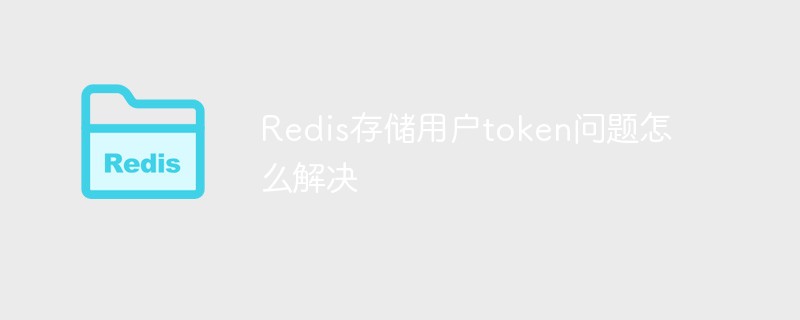This article mainly introduces the method of Vue generating token and saving it in the client's localStorage. The editor thinks it is quite good. Now I will share it with you and give it as a reference. Let’s follow the editor to take a look, I hope it can help everyone.
We have already learned that data can be saved on the client (browser) through localStorage.
Our backend has such an interface:
http://localhost/yiiserver/web/index.php/token?client_appid=aaa&client_appkey=bbb
In fact, just Clients (understood as user table) generate a token


client_appid here is equivalent to the username, client_appkey is equivalent to the password.
In this way, a access-token will be generated after backend authentication. We need to save this access-token on the client.
Note: Our front-end is generally deployed on another server and will cross domains. The back-end needs to handle cross-domain issues. You can write the following code in PHP:
//指定允许其他域名访问
header("Access-Control-Allow-Origin: *");
header("Access-Control-Allow-Methods: GET,POST");
header('Access-Control-Allow-Headers: X-Requested-With,content-type,if-modified-since');Front-end routine
Note that since our project has already used VueX, then I will definitely use Store(Concept in vuex) to create a module.

We have created a new UsersModule.js to handle the user login business. Be careful not to forget to add the entry file users-index Introduced in .js. If our "Member Backstage" also needs user-related data, it must also be introduced.
Modify in users-index.js:
//引入模块
import ResModule from './../Store/modules/ResModules';
import UsersModule from "./../Store/modules/UsersModule";
const vuex_config = new Vuex.Store({
modules: {
res:ResModule,
users:UsersModule
}
});1, UsersModule.js
import Vue from "vue";
export default {
state:{
currentUser:{
get UserName(){
return localStorage.getItem("currentUser_name");
},
get UserToken(){
return localStorage.getItem("currentUser_token");
}
}
},
mutations:{
setUser(state,{user_name,user_token}){
// 在这里把用户名和token保存起来
localStorage.setItem("currentUser_name",user_name);
localStorage.setItem("currentUser_token",user_token);
}
},
actions:{
userLogin(context,{user_name,user_pass}){
// 发送get请求做权限认证(真实开发建议用post的方式)
let url = "http://localhost/yiiserver/web/index.php/token?client_appid="+user_name+"&client_appkey="+user_pass;
console.log(url);
Vue.http.get(url)
.then((res)=>{
if (res!=null && res.body!=undefined && "access-token" in res.body){
var token = res.body["access-token"];
if (token != ""){
// 后端API验证通过
// 调用上面mutations里定义的方法
context.commit("setUser",{"user_name":user_name,"user_token":token});
}
}else{
alert("用户名密码错误");
}
},(res)=>{
alert("请求失败进入这里")
});
}
}
}actions part: We wrote a userLogin() method to send an http request to the back-end server. The data returned successfully by the request calls the ## defined in the mutations part. #setUser() method is saved to the client.
userLogin() method in actions is for calling on the user login page, that is, in userslogin.vue.
userlogin.vue and modify the following code:
localStorage中:
methods:{
login(){
// 这个验证是element-ui框架提供的方法
this.$refs["users"].validate(function (flag) {
if(flag){
/*localStorage.setItem("currentUser",this.UserModel.user_name);
alert("用户登录成功");*/
this.$store.dispatch("userLogin",{"user_name":this.UserModel.user_name,"user_pass":this.UserModel.user_pass})
}else{
alert("用户名密码必填");
}
}.bind(this));
}
}

member-index.js of the member backend module:
//引入Module
import ResModule from './../Store/modules/ResModules';
import UsersMoule from "./../Store/modules/UsersModule";
const vuex_config = new Vuex.Store({
modules: {
res:ResModule,
users:UsersMoule
}
}); Then we can , for example, in the navigation bar component navbar.vue:
<a href="##" rel="external nofollow" >{{this.$store.state.users.currentUser.UserName}}</a>In this way, access the properties in users. 
Vue-resource interceptor determines the token invalid jump detailed explanation
Vue uses token to jump to the login page after it expires
Detailed example of jQuery Ajax using token to verify identity
The above is the detailed content of Vue generates token and saves it in the client. Detailed explanation. For more information, please follow other related articles on the PHP Chinese website!
![VMware Horizon Client无法打开[修复]](https://img.php.cn/upload/article/000/887/227/170835607042441.jpg) VMware Horizon Client无法打开[修复]Feb 19, 2024 pm 11:21 PM
VMware Horizon Client无法打开[修复]Feb 19, 2024 pm 11:21 PMVMwareHorizon客户端可帮助您便捷地访问虚拟桌面。然而,有时虚拟桌面基础设施可能会遇到启动问题。本文将讨论当VMwareHorizon客户端未能成功启动时,您可以采取的解决方法。为什么我的VMwareHorizon客户端无法打开?在配置VDI时,如果未打开VMWareHorizon客户端,可能会出现错误。请确认您的IT管理员提供了正确的URL和凭据。如果一切正常,请按照本指南中提到的解决方案解决问题。修复未打开的VMWareHorizon客户端如果您的Windows计算机上未打开VMW
![VMware Horizon客户端在连接时冻结或停滞[修复]](https://img.php.cn/upload/article/000/887/227/170942987315391.jpg) VMware Horizon客户端在连接时冻结或停滞[修复]Mar 03, 2024 am 09:37 AM
VMware Horizon客户端在连接时冻结或停滞[修复]Mar 03, 2024 am 09:37 AM在使用VMWareHorizon客户端连接到VDI时,我们可能会遇到应用程序在身份验证过程中冻结或连接阻塞的情况。本文将探讨这个问题,并提供解决这种情况的方法。当VMWareHorizon客户端出现冻结或连接问题时,您可以采取一些措施来解决这一问题。修复VMWareHorizon客户端在连接时冻结或卡住如果VMWareHorizon客户端在Windows11/10上冻结或无法连接,请执行下面提到的解决方案:检查网络连接重新启动Horizon客户端检查Horizon服务器状态清除客户端缓存修复Ho
 登录token无效问题如何解决Sep 14, 2023 am 10:57 AM
登录token无效问题如何解决Sep 14, 2023 am 10:57 AM登录token无效问题可以通过检查网络连接、检查token有效期、清除缓存和Cookie、检查登录状态、联系应用程序开发者和加强账号安全来解决。详细介绍:1、检查网络连接,重新连接网络或者更换网络环境;2、检查token有效期,重新获取一个新的token,或者联系应用程序的开发者;3、清除缓存和Cookie,清除浏览器缓存和Cookie,然后重新登录应用程序;4、检查登录状态。
 登录token无效怎么办Sep 14, 2023 am 11:33 AM
登录token无效怎么办Sep 14, 2023 am 11:33 AM登录token无效的解决办法有检查Token是否过期、检查Token是否正确、检查Token是否被篡改、检查Token是否与用户匹配、清除缓存或Cookie、检查网络连接和服务器状态、重新登录或请求新的Token、联系技术支持或开发人员等。详细介绍:1、检查Token是否过期,登录Token通常会设置有效期,一旦超过有效期,就会被认为无效等等。
 Redis存储用户token问题怎么解决May 31, 2023 am 08:06 AM
Redis存储用户token问题怎么解决May 31, 2023 am 08:06 AMRedis存储用户token在设计类似电商的系统时,一个常见的需求是每个页面都需要携带登录用户信息。常见的解决方法有两种:使用cookie保存使用JWT保存但如果系统中使用了Redis缓存,那么还可以有第三种解决方案–将用户token缓存在Redis中。登陆时生成一个token存入Redis//生成一个token对象,保存在redis中redisTemplate.opsForHash().put("token","user",user)
 PHP MQTT客户端开发指南Mar 27, 2024 am 09:21 AM
PHP MQTT客户端开发指南Mar 27, 2024 am 09:21 AMMQTT(MessageQueuingTelemetryTransport)是一种轻量级的消息传输协议,通常用于物联网设备之间的通信。PHP是一种常用的服务器端编程语言,可以用来开发MQTT客户端。本文将介绍如何使用PHP开发MQTT客户端,并包含以下内容:MQTT协议的基本概念PHPMQTT客户端库的选取和使用实例:使用PHPMQTT客户端发布和
 Vue3+Vite怎么使用双token实现无感刷新May 10, 2023 pm 01:10 PM
Vue3+Vite怎么使用双token实现无感刷新May 10, 2023 pm 01:10 PM一、token登录鉴权jwt:JSONWebToken。是一种认证协议,一般用来校验请求的身份信息和身份权限。由三部分组成:Header、Hayload、Signatureheader:也就是头部信息,是描述这个token的基本信息,json格式{"alg":"HS256",//表示签名的算法,默认是HMACSHA256(写成HS256)"type":"JWT"//表示Token的类型,JWT令牌统一写为JWT}pa
 手机客户端是什么Aug 16, 2023 pm 01:40 PM
手机客户端是什么Aug 16, 2023 pm 01:40 PM手机客户端是指一种在智能手机上运行的应用程序,通过原生客户端或Web客户端的形式为用户提供各种功能和服务。手机客户端可以分为原客户端和Web客户端两种形式,原生客户端是指使用特定编程语言和开发工具,为特定的操作系统编写的应用程序,Web客户端的优势在于跨平台兼容性好,可以不受操作系统限制在不同设备上运行,但相对于原生客户端,Web客户端的性能和用户体验可能有所降低。


Hot AI Tools

Undresser.AI Undress
AI-powered app for creating realistic nude photos

AI Clothes Remover
Online AI tool for removing clothes from photos.

Undress AI Tool
Undress images for free

Clothoff.io
AI clothes remover

AI Hentai Generator
Generate AI Hentai for free.

Hot Article

Hot Tools

PhpStorm Mac version
The latest (2018.2.1) professional PHP integrated development tool

MantisBT
Mantis is an easy-to-deploy web-based defect tracking tool designed to aid in product defect tracking. It requires PHP, MySQL and a web server. Check out our demo and hosting services.

SublimeText3 Linux new version
SublimeText3 Linux latest version

SecLists
SecLists is the ultimate security tester's companion. It is a collection of various types of lists that are frequently used during security assessments, all in one place. SecLists helps make security testing more efficient and productive by conveniently providing all the lists a security tester might need. List types include usernames, passwords, URLs, fuzzing payloads, sensitive data patterns, web shells, and more. The tester can simply pull this repository onto a new test machine and he will have access to every type of list he needs.

EditPlus Chinese cracked version
Small size, syntax highlighting, does not support code prompt function






